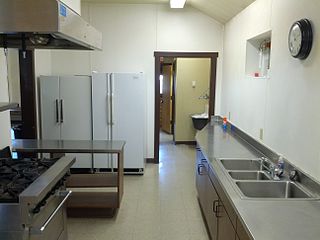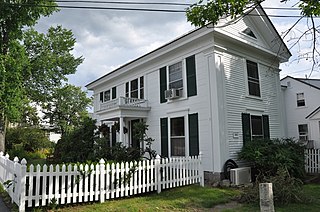
Little Bighorn Battlefield National Monument preserves the site of the June 25 and 26, 1876, Battle of the Little Bighorn, near Crow Agency, Montana, in the United States. It also serves as a memorial to those who fought in the battle: George Armstrong Custer's 7th Cavalry and a combined Lakota-Northern Cheyenne and Arapaho force. Custer National Cemetery, on the battlefield, is part of the national monument. The site of a related military action led by Marcus Reno and Frederick Benteen is also part of the national monument, but is about 3 miles (4.83 km) southeast of the Little Bighorn battlefield.
The Wyoming Governor's Mansion is the official residence of the governor of Wyoming. The current mansion was built during 1976 in Cheyenne.

Grand Canyon Village Historic District comprises the historic center of Grand Canyon Village, on the South Rim of the Grand Canyon in Grand Canyon National Park, Arizona. The district includes numerous landmark park structures, many of which are National Historic Landmarks themselves, or are listed on the National Register of Historic Places. The town design as a whole is also significant for its attention to integration with the Grand Canyon landscape, its incorporation of National Park Service Rustic design elements, and for the idiosyncratic design of park concessioner structures such as the El Tovar Hotel.

The Moffatt-Ladd House, also known as the William Whipple House, is a historic house museum and National Historic Landmark in Portsmouth, New Hampshire, United States. The 1763 Georgian house was the home of William Whipple (1730–1785), a Founding Father, a signer of the Declaration of Independence and Revolutionary War general. The house is now owned by the National Society of Colonial Dames in New Hampshire, and is open to the public.

The Dull Knife Battlefield is located on the eastern slope of the Bighorn Mountains in Johnson County, Wyoming near Kaycee. It was the scene of the Dull Knife Fight on November 25, 1876, in which the Fourth Cavalry under General Ranald S. Mackenzie raided the winter encampment of the NorthernCheyenne, destroying most of their material culture and all their winter supplies and thus forcing the Northern Cheyenne to seek shelter with the village of Crazy Horse in order to survive the winter. Five hundred ponies were captured and about 173 lodges destroyed. The Dull Knife battlefield is on private land and is available to visit only by special arrangement. The fight took place on November 25, 1876.

There are 75 properties listed on the National Register of Historic Places in Albany, New York, United States. Six are additionally designated as National Historic Landmarks (NHLs), the most of any city in the state after New York City. Another 14 are historic districts, for which 20 of the listings are also contributing properties. Two properties, both buildings, that had been listed in the past but have since been demolished have been delisted; one building that is also no longer extant remains listed.
Whipple House may refer to:

This is a list of the National Register of Historic Places listings in Clark County, Wisconsin. It is intended to provide a comprehensive listing of entries in the National Register of Historic Places that are located in Clark County, Wisconsin. The locations of National Register properties for which the latitude and longitude coordinates are included below may be seen in a map.

The William Sturgis House was built by cattle baron William Sturgis in Cheyenne, Wyoming in 1884. The Shingle Style house was designed by architect George D. Rainsford, a New York architect who moved to Wyoming to raise Morgan horses and Clydesdales. While horse breeding was his principal occupation, Rainsford continued to practice architecture, designing many of the houses in the neighborhood surrounding the Sturgis residence.

William Dubois (1879–1953) was an American architect and politician. He was a prolific architect in Wyoming and nearby states, and served five terms in both houses of the Wyoming Legislature.

Hynds Lodge is a conference and accommodation lodge originally built by Cheyenne, Wyoming businessman Harry P. Hynds and donated to the Boy Scouts of America (BSA) in 1922. It is open from May 1 to October 1 by reservation only. It has accommodations for 30 people, a large kitchen, dining room, living room, covered porch, stone fireplace and chimney, and 9 acres (3.6 ha) of land. The lodge was originally used by Wyoming Boy Scouts as a recreational camp. Later it was used by churches, social groups, and businesses. It was built on land that became part of Curt Gowdy State Park in 1971 and is now operated by the park. The south fork of Crow Creek lies nearby, with a granite outcrop and woodlands of cedar and spruce.
The Biesterfeldt Site is an archaeological site near Lisbon, North Dakota, United States, located along the Sheyenne River. The site is the only documented village of earth lodges in the watershed of the Red River, and the only one that has been unambiguously affiliated with the Cheyenne tribe. An independent group of Cheyennes is believed to have occupied it c. 1724–1780. In 1980, the site was listed on the National Register of Historic Places because of its archaeological significance. It was designated a National Historic Landmark in 2016.

The Nelson Wheeler Whipple House is an adobe house in Salt Lake City, Utah, United States built in 1854. Whipple was born in Sanford, New York in 1818, converting to Mormonism in 1844 and moving to Nauvoo, Illinois. After fleeing Nauvoo in 1846, Whipple lived in Garden Grove, Iowa until 1850, when he and his family moved to Salt Lake City. There he acquired two more wives and 17 children, providing wood shingles for the Mormon Tabernacle and keeping a diary that has become an important historical resource.

The Dr. Solomon M. Whipple House, also known as the Clough or Woodward House, is a historic house on Main Street in the center of New London, New Hampshire. Built in 1850 for a long-serving doctor, it is the only Greek Revival house in the town. It was listed on the National Register of Historic Places in 1985. It is now the front portion of an assisted living facility.

The Whipple House is a historic house museum at 4 Pleasant Street in Ashland, New Hampshire. Built about 1837, it is a well-preserved example of a mid-19th century Cape-style house, that is relatively architecturally undistinguished. It is significant for its association with George Hoyt Whipple (1878–1976), a Nobel Prize-winning doctor and pathologist who was born here. Whipple gave the house to the town in 1970, and it is now operated by the Ashland Historical Society as a museum, open during the warmer months. The house was listed on the National Register of Historic Places in 1978.

The Lacey Street Theatre building, now hosting the Fairbanks Ice Museum, is an Art Deco architectural showpiece theatre located at 500 Second Avenue in Fairbanks, Alaska. It was designed by noted theatre designer B. Marcus Priteca, and built in 1939 by C.W. Hufeisen for Austin E. "Cap" Lathrop, one of a chain of movie theaters built by Lathrop across Alaska, and one of only two in Fairbanks into the 1960s. It opened on January 25, 1940. It closed in December 1980, and was repurposed to house the museum in 1992.

Lacey-Keosauqua State Park is located southwest of Keosauqua, Iowa, United States. The park is located along the Des Moines River in Van Buren County. First dedicated in 1921, it is the largest state park in size in Iowa. In 1990, three areas were named nationally recognized historic districts and listed on the National Register of Historic Places.

The Downtown Cheyenne Historic District in Cheyenne, Wyoming is a historic district that was listed on the National Register of Historic Places in 1978. It is an area of about seven blocks, in the core of the original business district of Cheyenne, and home of many of the first masonry commercial buildings in Cheyenne.
Sherwood Lodge, in Glacier National Park near West Glacier, Montana, was built in 1919. It was listed on the National Register of Historic Places in 2008.
















